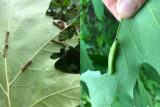Hungry Birds Count on Caterpillars
This lesson is designed for 4th-6th graders and is recommended for use from June through September.
 Science students will carry out a survey of tree leaves to determine numbers and types of caterpillars, spiders, and other insects that are available as food for songbirds. They will follow a scaled down version of the protocol that has been performed by scientists at Hubbard Brook Experimental Forest for many decades.
Science students will carry out a survey of tree leaves to determine numbers and types of caterpillars, spiders, and other insects that are available as food for songbirds. They will follow a scaled down version of the protocol that has been performed by scientists at Hubbard Brook Experimental Forest for many decades.
We have designed this outdoor activity for students to conduct independently in their backyards, or in their schoolyards in the company of their classmates. Teachers will find all the necessary instructional resources to implement this activity either remotely, or in person, including teacher notes, an 11-minute video introducing students to migratory bird researchers at Hubbard Brook, student directions, student data sheets, and a caterpillar counting training video. Students are guided to make connections between their observations and interactions between bird survival and food abundance, timing of bird arrival and insect emergence, and impacts of climate change on the ecosystem.
